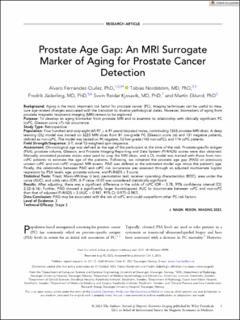| dc.identifier.citation | Fernandez‐Quilez, A., Nordström, T., Jäderling, F., Kjosavik, S. R., & Eklund, M. (2023). Prostate age gap: An MRI surrogate marker of aging for prostate cancer detection. Journal of Magnetic Resonance Imaging. | en_US |
| dc.description.abstract | Background
Aging is the most important risk factor for prostate cancer (PC). Imaging techniques can be useful to measure age-related changes associated with the transition to diverse pathological states. However, biomarkers of aging from prostate magnetic resonance imaging (MRI) remain to be explored.
Purpose
To develop an aging biomarker from prostate MRI and to examine its relationship with clinically significant PC (csPC, Gleason score ≥7) risk occurrence.
Study Type
Retrospective.
Population
Four hundred and sixty-eight (65.97 ± 6.91 years) biopsied males, contributing 7243 prostate MRI slices. A deep learning (DL) model was trained on 3223 MRI slices from 81 low-grade PC (Gleason score ≤6) and 131 negative patients, defined as non-csPC. The model was tested on 90 negative, 52 low-grade (142 non-csPC), and 114 csPC patients.
Field Strength/Sequence
3-T, axial T2-weighted spin sequence.
Assessment
Chronological age was defined as the age of the participant at the time of the visit. Prostate-specific antigen (PSA), prostate volume, Gleason, and Prostate Imaging-Reporting and Data System (PI-RADS) scores were also obtained. Manually annotated prostate masks were used to crop the MRI slices, and a DL model was trained with those from non-csPC patients to estimate the age of the patients. Following, we obtained the prostate age gap (PAG) on previously unseen csPC and non-csPC cropped MRI exams. PAG was defined as the estimated model age minus the patient's age. Finally, the relationship between PAG and csPC risk occurrence was assessed through an adjusted multivariate logistic regression by PSA levels, age, prostate volume, and PI-RADS ≥ 3 score.
Statistical Tests
T-test, Mann–Whitney U test, permutation test, receiver operating characteristics (ROC), area under the curve (AUC), and odds ratio (OR). A P value <0.05 was considered statistically significant.
Results
After adjusting, there was a significant difference in the odds of csPC (OR = 3.78, 95% confidence interval [CI]: 2.32–6.16). Further, PAG showed a significantly larger bootstrapped AUC to discriminate between csPC and non-csPC than that of adjusted PI-RADS ≥ 3 (AUC = 0.981, 95% CI: 0.975–0.987). | en_US |

